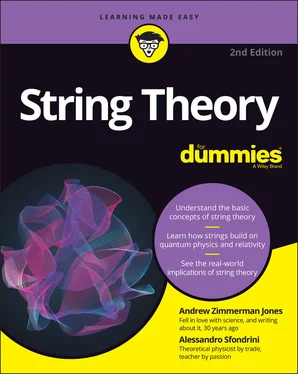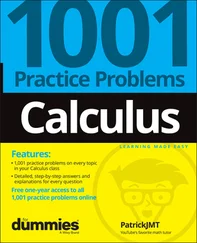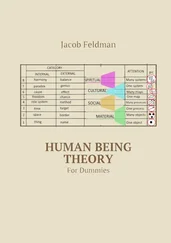Newton’s Revolution: How Physics Was Born
Many see Sir Isaac Newton’s discoveries as the start of modern physics (along with a bit of help from his predecessor Galileo Galilei). Newton’s discoveries dominated two centuries of physics, until Albert Einstein took his place at the apex of scientific greatness.
Newton’s accomplishments are diverse, but he’s known largely for four crucial discoveries that define the realm of physics even today:
Three laws of motion
Law of universal gravitation
Optics
Calculus
Each of these discoveries has elements that will prove important as you attempt to understand the later discoveries of string theory.
Force, mass, and acceleration: Putting objects into motion
Newton formulated three laws of motion, which showed his understanding of the real meaning of motion and how it relates to force. Under his laws of motion, a force creates a proportional acceleration on an object.
This understanding was a necessary foundation upon which his law of gravity was built (see the next section). In fact, both were introduced in his 1686 book, Philosophiae Naturalis Principia Mathematica, a title that translates to Mathematical Principles of Natural Philosophy. This book has become known in physics circles by the shorter title Principia .
The second law of motion says that the force required to accelerate an object is the product of the mass and acceleration, expressed by the equation F = ma, where F is the total force, m is the object’s mass, and a is the acceleration. To figure out the total acceleration on an object, you figure out the total forces acting on it and then divide by the mass.
 Strictly speaking, Newton said that force is equal to the change in momentum of an object. In calculus, this is the derivative of momentum with respect to time. Momentum is equal to mass times velocity. Because mass is assumed to be constant and the derivative of velocity with respect to time yields the acceleration, the popular F = ma equation is a simplified way of looking at this situation.
Strictly speaking, Newton said that force is equal to the change in momentum of an object. In calculus, this is the derivative of momentum with respect to time. Momentum is equal to mass times velocity. Because mass is assumed to be constant and the derivative of velocity with respect to time yields the acceleration, the popular F = ma equation is a simplified way of looking at this situation.
 This equation can also be used to define inertial mass. If we take a force and divide it by the acceleration it causes on an object, we can determine the mass of the object. One question string theorists hope to answer is why some objects have mass and others (such as the photon) do not.
This equation can also be used to define inertial mass. If we take a force and divide it by the acceleration it causes on an object, we can determine the mass of the object. One question string theorists hope to answer is why some objects have mass and others (such as the photon) do not.
NEWTON MAKES SOME LAWS ABOUT MOTION
Newton’s second law of motion, and the way it relates force, acceleration, and mass, is the only law of motion relevant to a string theory discussion. However, for true Newton-o-philes, here are the other two laws of motion, paraphrased for ease of understanding:
Newton’s first law of motion: An object at rest remains at rest, or an object in motion remains in motion, unless acted upon by an external force. In other words, it takes a force to cause motion to change.
Newton’s third law of motion: When two objects interact through a force, each object exerts a force on the other object that is equal and opposite. In other words, if we exert a force on a wall with a hand, the wall exerts an equal force back on the hand.
Gravity: A great discovery
With the laws of motion in hand, Newton was able to perform the action that would make him the greatest physicist of his age: explaining the motion of the heavens and Earth. His proposal was the law of universal gravitation, which defines a force acting between two objects based on their masses and the distance separating them.
The more massive the objects are, the higher the gravitational force is. The relationship with distance is an inverse relationship, meaning that as the distance increases, the force drops off. (It actually drops off with the square of the distance — so it drops off very quickly as objects are separated.) The closer two objects are, the higher the gravitational force is.
The strength of the gravitational force determines a value in Newton’s equation called the universal constant of gravitation or Newton’s constant. A striking property of the universal constant of gravitation is that it is … well, universal. This means that its value is the same in New York, Tokyo, Mars, Alpha Centauri, or the Andromeda galaxy. This value is obtained by performing laboratory experiments and astronomical observations, and calculating what the constant should be. One question still open to physics and string theory is why gravity is so weak compared to other forces.
 Gravity seems fairly straightforward, but it actually causes quite a few problems for physicists because it won’t behave itself and get along with the other forces of the universe. Newton himself wasn’t comfortable with the idea of a force acting at a distance, without understanding the mechanism involved. But the equations, even without a thorough explanation for what causes gravity, worked. In fact, the equations worked well enough that for more than two centuries, until Einstein, no one could figure out what was missing from the theory. More on this in Chapter 6.
Gravity seems fairly straightforward, but it actually causes quite a few problems for physicists because it won’t behave itself and get along with the other forces of the universe. Newton himself wasn’t comfortable with the idea of a force acting at a distance, without understanding the mechanism involved. But the equations, even without a thorough explanation for what causes gravity, worked. In fact, the equations worked well enough that for more than two centuries, until Einstein, no one could figure out what was missing from the theory. More on this in Chapter 6.
Optics: Shedding light on light’s properties
Newton also performed extensive work in understanding the properties of light, a field known as optics. Newton supported a view that light moves as tiny particles, as opposed to a theory that light travels as a wave. He performed all his work in optics assuming that light moves as tiny balls of energy flying through the air.
For nearly a century, Newton’s view of light as particles dominated, until Thomas Young’s experiments in the early 1800s demonstrated that light exhibits the properties of waves — namely, the principle of superposition (see the earlier “ Catching the wave” section for more on superposition and the later “ Light as a wave: The ether theory” section for more on light waves).
The understanding of light, which began with Newton, would lead to the revolutions in physics by Albert Einstein and, ultimately, to the ideas at the heart of string theory. In string theory, both gravity and light are caused by the behavior of strings.
Calculus and mathematics: Enhancing scientific understanding
To study the physical world, Newton had to develop new mathematical tools. One of the tools he developed was a type of math that we call calculus. At the same time Newton invented it, philosopher and mathematician Gottfried Leibniz also created calculus completely independently! Newton needed calculus to perform his analysis of the natural world. Leibniz, on the other hand, developed it mainly to explain certain geometric problems.
 Think for a moment how amazing this really is. A purely mathematical construct, calculus, provided key insights into the physical systems that Newton explored. Alternately, the physical analysis that Newton performed led him to create calculus. In other words, this is a case where mathematics and physics seemed to help build upon each other! One of the major successes of string theory is that it has provided motivation for important mathematical developments that have gone on to be useful in other realms.
Think for a moment how amazing this really is. A purely mathematical construct, calculus, provided key insights into the physical systems that Newton explored. Alternately, the physical analysis that Newton performed led him to create calculus. In other words, this is a case where mathematics and physics seemed to help build upon each other! One of the major successes of string theory is that it has provided motivation for important mathematical developments that have gone on to be useful in other realms.
Читать дальше

 Strictly speaking, Newton said that force is equal to the change in momentum of an object. In calculus, this is the derivative of momentum with respect to time. Momentum is equal to mass times velocity. Because mass is assumed to be constant and the derivative of velocity with respect to time yields the acceleration, the popular F = ma equation is a simplified way of looking at this situation.
Strictly speaking, Newton said that force is equal to the change in momentum of an object. In calculus, this is the derivative of momentum with respect to time. Momentum is equal to mass times velocity. Because mass is assumed to be constant and the derivative of velocity with respect to time yields the acceleration, the popular F = ma equation is a simplified way of looking at this situation. This equation can also be used to define inertial mass. If we take a force and divide it by the acceleration it causes on an object, we can determine the mass of the object. One question string theorists hope to answer is why some objects have mass and others (such as the photon) do not.
This equation can also be used to define inertial mass. If we take a force and divide it by the acceleration it causes on an object, we can determine the mass of the object. One question string theorists hope to answer is why some objects have mass and others (such as the photon) do not.










